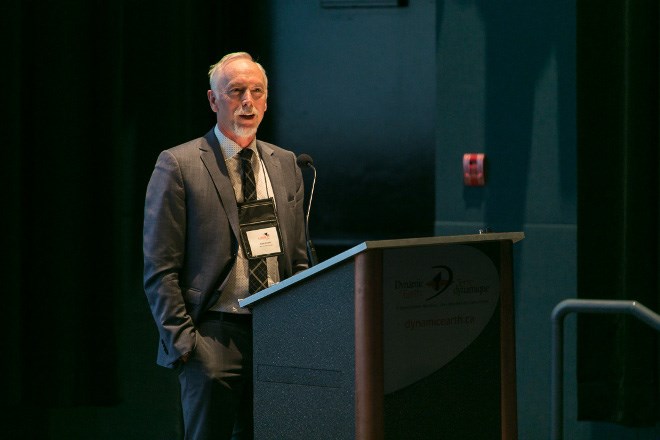Al Coutts was working as chief geologist for Falconbridge at Kidd Mines in Timmins when he got the big break he had been waiting for: a promotion to mine manager.
It had been his goal to work in Sudbury where the big mines were, and Coutts felt like he had finally made it. But he hadn’t been celebrating long when his boss, Warren Holmes, broke the news that Coutts wouldn’t be posted to Sudbury, but to Raglan Mine, situated on the Ungava Peninsula in remote Québec.
He was visibly disappointed, until his boss delivered some sage words of advice.
“It's one thing to earn your opportunity,” Coutts, the current president and CEO of Noront Resources, recalled Holmes saying. “And it's another thing to see it and take it when it's staring you in the face.”
Sure enough, Holmes was right, Coutts said, and he later recognized the post as the gift it was.
“That operation shaped the entirety of my career,” Coutts said. “Learning French, working closely with Indigenous partners, working in remote operations – this had a profound effect on everything I did after that.”
Lessons learned from more than 30 years in mining were imparted by Coutts to a group of post-secondary geoscience students gathered in Sudbury on May 3 for the 2019 Student-Industry Mineral Exploration Workshop (S-IMEW).
Hosted annually by the Prospectors and Developers Association of Canada (PDAC), the workshop sponsors 26 students who spend two weeks going on field trips and mine tours, undertaking mapping exercises, and listening in on lectures as an introduction to the workforce.
At each step of his career, which took him across Canada and around the world, Coutts said he learned a valuable lesson.
In Sweden, at Boliden’s Kristineberg Mine, he was inspired by the company’s thoughtful approach to development, which focused on protecting the environment. The company used rubber-tired equipment in the forest – a novelty at the time – preserved trees where they could, and collected contaminants to avoid polluting the water, he noted.
At Kidd Creek, Coutts said, he learned what it means for a company to be a good corporate citizen. The mine operators, Texas Gulf, and later Falconbridge, valued their employees, treating them well, and they were actively involved in the community, sponsoring a wide variety of charitable events and causes.
When he got to New Caledonia in the South Pacific, Falconbridge (which later became Xstrata) had been tasked with developing a nickel laterite operation in partnership with the Indigenous Kanak people. The project called for development to take place near a highly sensitive coral reef, which had been designated a UNESCO heritage site.
“Falconbridge had this great reputation of how they worked conscientiously and in partnership with local Indigenous peoples, and when the Kanak people of New Caledonia were looking for a partner to develop the best undeveloped projects in the world, they came to Falconbridge,” Coutts said.
Coutts said each of these experiences helped prepare him for his return to Canada just over four years ago to take on his current role at Noront Resources, the primary company seeking to develop the massive Ring of Fire chromite deposit located in the remote James Bay lowlands in Northern Ontario.
Noront currently owns about 85 per cent of the mining claims in the area, which boasts a whopping 250 million tonnes of chromite, an essential component to making stainless steel.
Coutts described it as a “100-year opportunity” that could have a lasting legacy of employment and prosperity for both the company and the Indigenous people living in the area.
But development will be complex, requiring “lots of investment and lots of infrastructure,” Coutts said. Of primary importance is consultation with the local Indigenous peoples.
After decades of disappointment in dealing with companies seeking development opportunities, the First Nations were understandably skeptical of Noront’s intentions, Coutts said. That’s why the company has taken extensive measures to connect with and involve them in the process.
“We needed to demonstrate our commitment, we needed to build the relationships, and you don’t build relationships in a couple of weeks,” he said. “You build them over years, and that’s what we’ve been doing.”
With chromite seams visible at surface, the company would traditionally develop an open pit before going underground.
But community members expressed concern about any mining operation denuding the area, polluting the water, and leaving an industrial wasteland. That caused Noront to return to the drawing board.
“We committed to not disturbing any more land than our camp currently sits on,” he said. “That’s it. That’s all we’re going to do.”
The development now calls for an underground operation, with all tailings going back underground as cemented paste fill.
Coutts said Noront is also funding area First Nations to lead the environmental assessment process. Noront will provide the capital and technical support, but the First Nations will be responsible for hiring the engineering and environmental firms to do the work, incorporating their traditional knowledge into the permitting process.
And Marten Falls First Nation, which, along with Webequie First Nation, are traditional users of the land there, has signed on to become a shareholder of Noront.
Coutts said this type of active engagement should, and likely will, become the norm for any mine development from now on.
“We felt we understood a lot of the concerns of the community and we tried to address them in how we designed the project, and I think this is at the heart of consultation,” Coutts said. “If you don't address those issues that you hear in consultation in the design, that's not really consultation, and that's part of our approach.”




